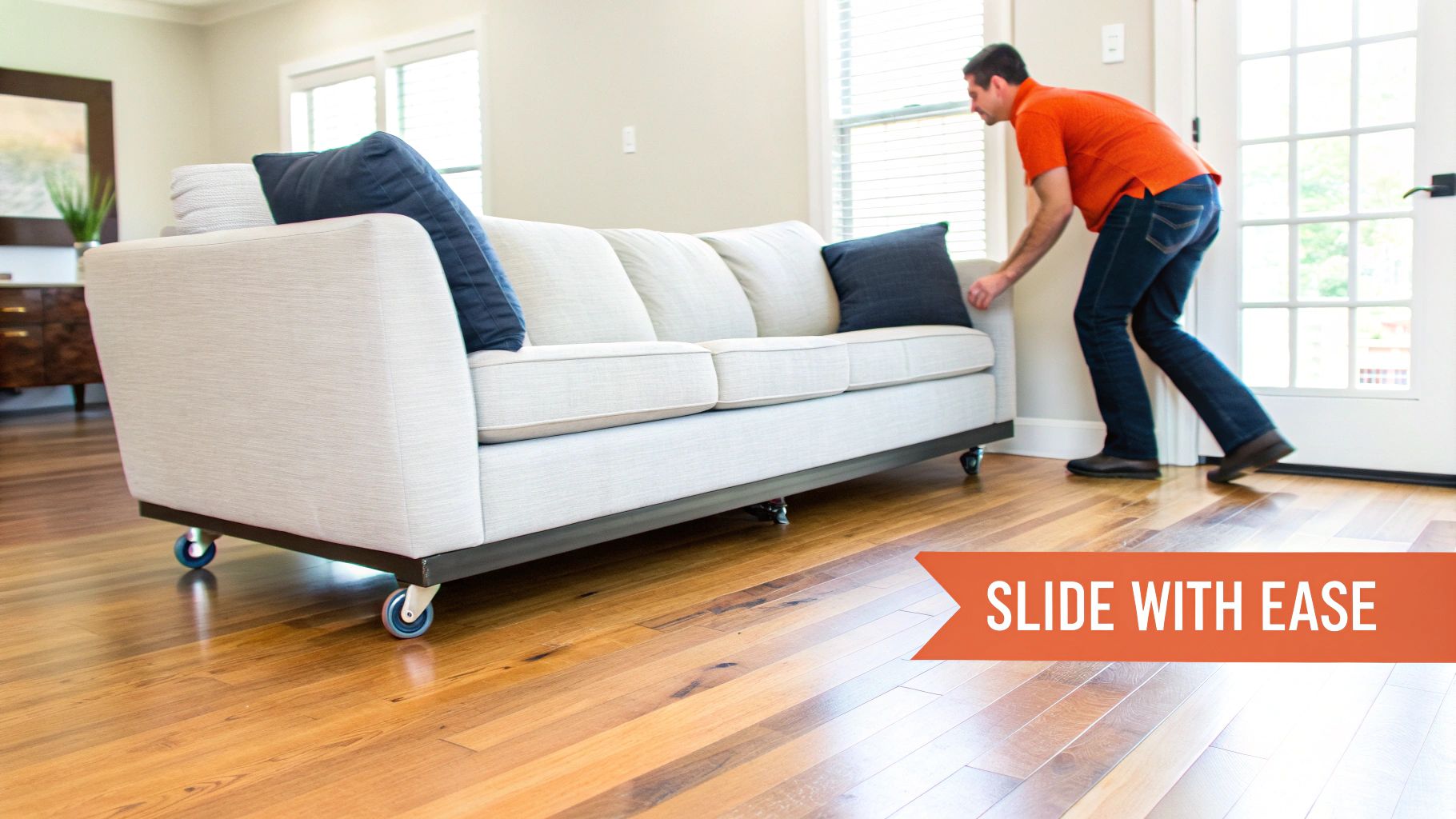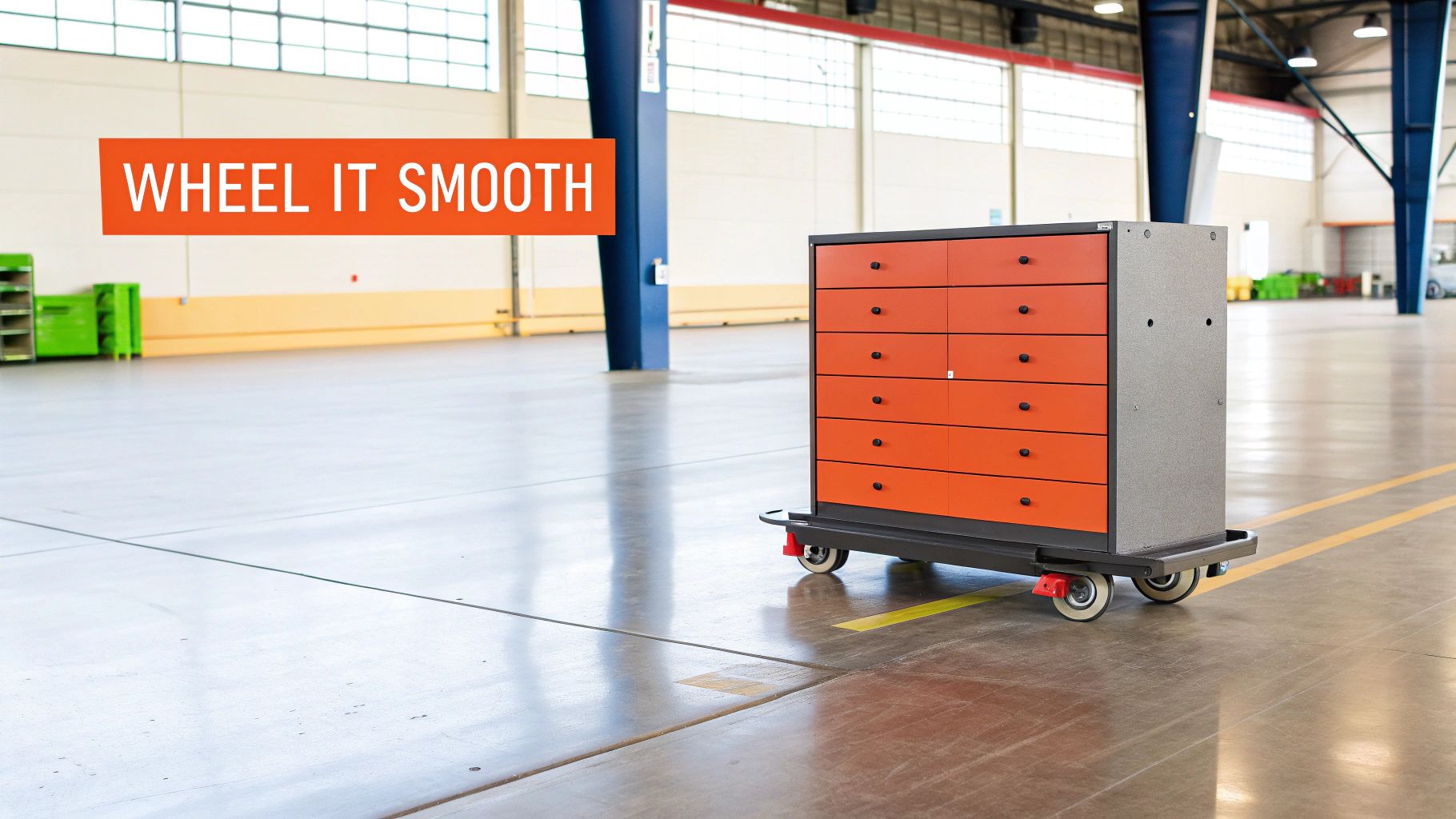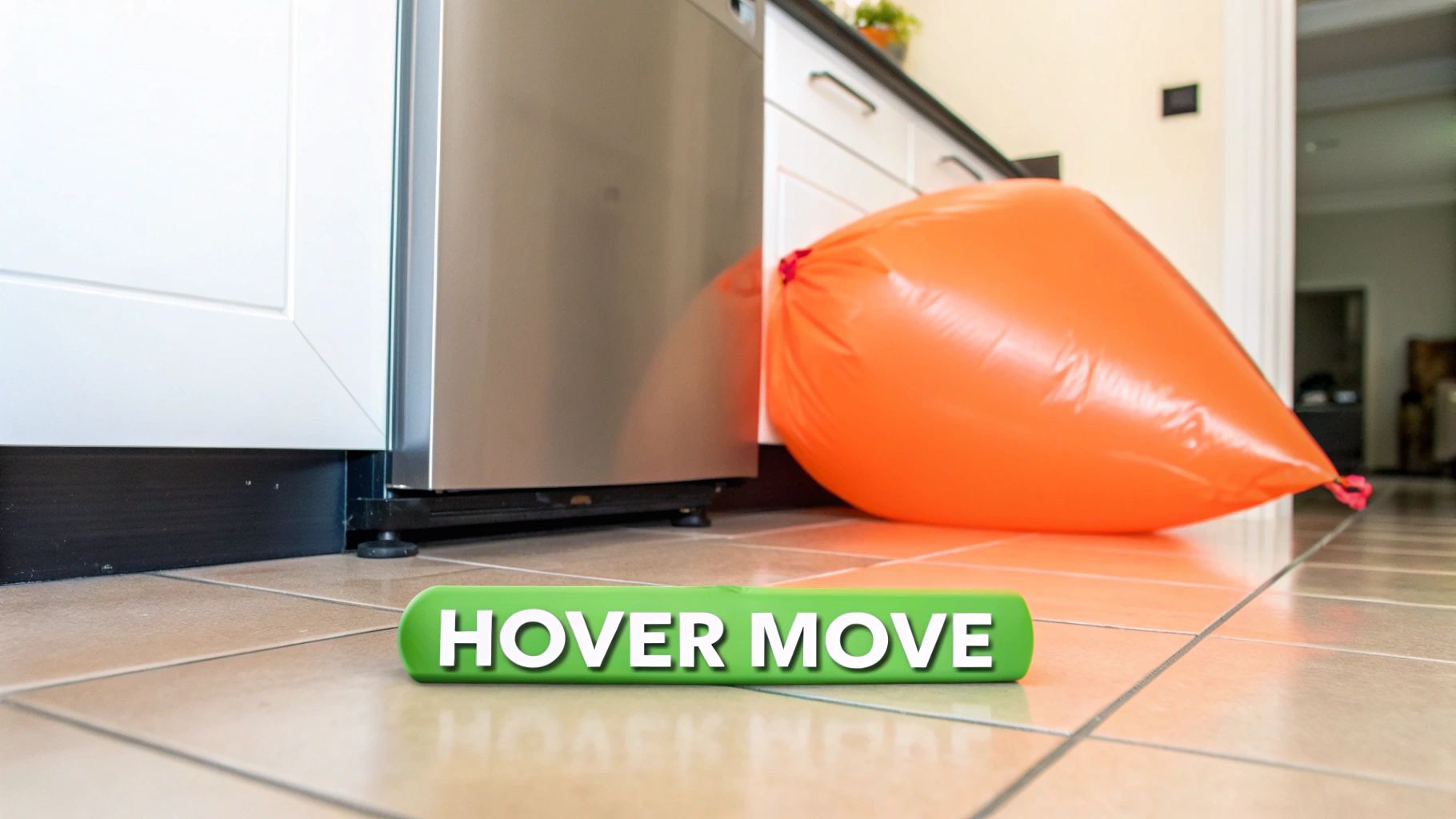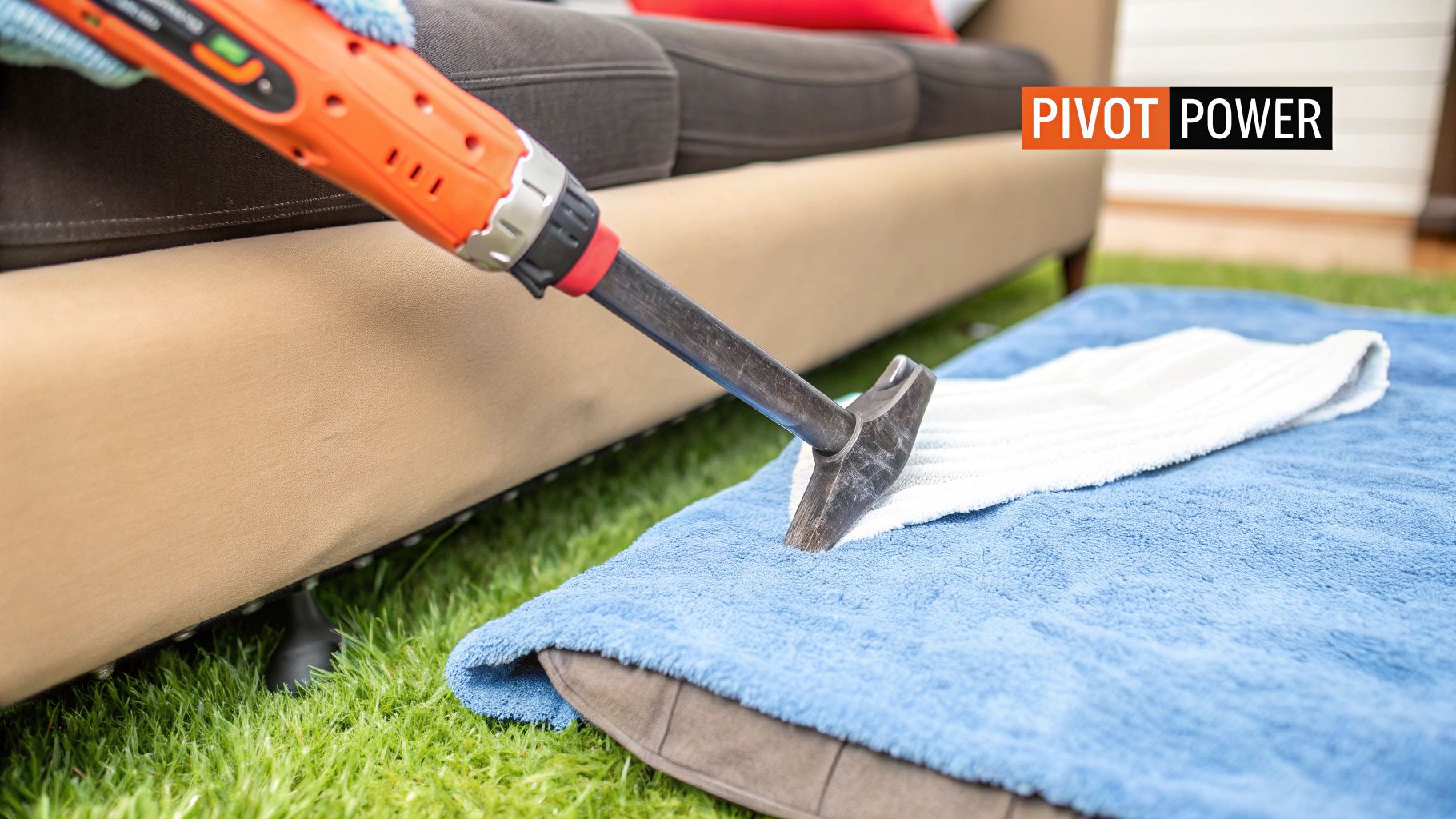-
CALL US:
- (866) 952-3456
Moving heavy furniture can be back-breaking work, but it doesn't have to be. This list provides six easy ways to move heavy furniture efficiently and safely, preventing injuries and protecting your floors. Whether you're rearranging or relocating, learn how furniture sliders, moving straps, dollies, air-powered movers, and smart leveraging techniques can simplify the process. Discover how furniture lifting jacks can make even the heaviest items manageable. These simple solutions save you time and effort, so you can get back to enjoying your space.
Looking for easy ways to move heavy furniture? Furniture sliders are your secret weapon. These small, flat discs, typically made of plastic, rubber, or felt, are placed under the legs or edges of furniture to drastically reduce friction with the floor. This allows you to glide even the bulkiest items across hardwood, tile, and even carpet with surprising ease. They work by creating a low-friction surface between your furniture and the floor, allowing you to effortlessly slide heavy items without scratching or damaging your floors. This simple solution can be a back-saver for anyone from busy professionals to seniors.

Furniture sliders deserve a top spot on this list because they offer an effective and affordable way to move heavy furniture, eliminating the need for excessive force and minimizing the risk of injury. They come in various sizes and materials to accommodate different floor types and furniture weights. Hard plastic sliders are ideal for carpeted surfaces, while soft felt sliders work best on hardwood or tile. This versatility makes them a practical tool for any home. Imagine easily rearranging your living room furniture for a party or quickly shifting a heavy bed for cleaning – furniture sliders make it possible.
Features and Benefits:
Pros and Cons:
Pros:
Cons:
Examples and Tips:
Real-world examples demonstrate the effectiveness of furniture sliders. Users have reported moving a 300-pound sofa across hardwood floors with ease using SuperSliders. Professional moving companies also utilize similar products like EZ Moves sliders for standard furniture relocation.
Here are some tips for optimal use:
While furniture sliders aren't suitable for extremely heavy items like pianos, they are a game-changer for most common household furniture. Whether you're a busy professional, a DIY enthusiast, or simply someone looking for an easier way to move heavy objects, furniture sliders are a valuable tool to have at your disposal. They make furniture rearranging less of a chore and more of a breeze, ultimately creating a more manageable and adaptable living environment.
Looking for an easy way to move heavy furniture without throwing out your back? Shoulder dollies, or moving straps, offer a practical and efficient solution. These ingenious systems consist of adjustable straps and harnesses that redistribute the weight of heavy items from your hands and back to your stronger muscle groups – your shoulders and legs. This leverage-based design allows two people to safely lift and carry furniture and appliances much heavier than they could manage individually, significantly reducing strain and the risk of injury. This method is an easy way to move heavy furniture, especially up and down stairs.

Shoulder dollies typically support 600-800 pounds, making them suitable for a wide range of furniture and appliances. The hands-free design allows for better visibility and control while moving, making navigating stairs and tight corners considerably easier. Features like adjustable straps ensure a comfortable fit for users of different sizes, and the compact, portable nature of these systems makes them easy to store when not in use. This approach is a particularly easy way to move heavy furniture for those who might not have access to other equipment like dollies or ramps.
For example, professional movers often use Shoulder Dolly brand straps to move heavy items like a 400-pound armoire up multiple flights of stairs. Similarly, delivery services frequently utilize Forearm Forklift straps for large appliance deliveries. These real-world examples demonstrate the effectiveness of shoulder dollies in various moving scenarios.
While the benefits are clear, it's important to be aware of the potential drawbacks. Shoulder dollies require two people to operate, necessitating coordination and communication. There's also a slight learning curve to master the proper lifting technique. With extremely heavy items, shoulder discomfort can occur, and they aren't ideal for individuals with pre-existing shoulder problems.
Tips for Using Shoulder Dollies:
Shoulder dollies deserve a spot on this list because they offer a safe and efficient way to move heavy furniture without specialized equipment or professional help. Brands like Shoulder Dolly, Forearm Forklift, Nielsen Products, Ready Lifter, and Lillie's Q Moving Straps have popularized this method, making it an accessible and affordable solution for anyone looking for an easy way to move heavy furniture.
Looking for an easy way to move heavy furniture? Furniture dollies are a simple yet effective solution. These wheeled platforms are specifically designed to transport heavy items, making them an ideal choice for everything from rearranging your living room to moving across town. They come in various styles, including flat platform dollies for general use and specialized furniture dollies with raised edges or lips to prevent items from sliding off. These dollies can support a substantial amount of weight, typically between 1,000 and 3,000 pounds, while their smooth-rolling casters allow for easy maneuverability across flat surfaces. This makes them an excellent choice for anyone looking for easy ways to move heavy furniture without risking injury.

From moving a heavy toolbox across a warehouse floor to transporting a bulky dresser across the house, furniture dollies are invaluable tools. Imagine a single person effortlessly moving a fully loaded Milwaukee 3-Drawer Tool Chest across a warehouse – a task that would be nearly impossible without a dolly. Similarly, think of the countless residential moves made easier by U-Haul furniture dollies, allowing individuals to transport heavy dressers, bookcases, and appliances with relative ease. These examples highlight the versatility and practicality of furniture dollies in various moving scenarios. Their low profile makes loading easier, and the availability of both wood and metal construction allows you to choose the best option for your needs. Many dollies also feature 360-degree swivel wheels for enhanced maneuverability.
Here are some essential tips for using furniture dollies safely and effectively:
While furniture dollies offer significant advantages, it's essential to be aware of their limitations. They are not designed for navigating stairs and require relatively smooth surfaces for optimal performance. Positioning a dolly under already-placed furniture can also be challenging. Furthermore, storing dollies can be cumbersome due to their size, and high-quality dollies can be a significant investment.
Despite these limitations, furniture dollies deserve a place on this list of easy ways to move heavy furniture because of their ability to eliminate the need for heavy lifting, reduce the risk of back injury, and provide stability during transport. They are reusable for multiple moving tasks, making them a valuable investment for anyone who frequently moves or rearranges furniture. Companies like U-Haul, Harbor Freight, Milwaukee, Vestil, and Capacity LLC, as well as professional moving companies, all rely on and popularize the use of these versatile tools, further highlighting their effectiveness.
Looking for an easy way to move heavy furniture without throwing out your back? Air-powered furniture movers offer a simple yet effective solution. These ingenious devices utilize compressed air to create a cushion of air beneath heavy objects, essentially turning them into temporary hovercrafts. This significantly reduces friction between the furniture and the floor, allowing you to glide even the bulkiest items across smooth surfaces with minimal effort. They typically consist of inflatable air bladders that, when pumped up, allow even extremely heavy items (typically 200-700 pounds per mover) to float on a thin layer of air.

This method is a game-changer for anyone looking for easy ways to move heavy furniture. Whether you're rearranging your living room, moving into a new home, or simply need to shift a heavy appliance for cleaning, air-powered movers can make the task significantly easier and safer. Imagine effortlessly repositioning a 600-pound gun safe, as demonstrated with the EZ Moves system, or smoothly sliding a refrigerator into a tight kitchen space, a common application for the Airsled system used by appliance delivery services. This technology empowers even a single person to move heavy items, eliminating the need for extra help.
Air-powered furniture movers deserve a spot on this list because they offer a practical solution to a common problem. They are particularly beneficial for people with limited mobility, seniors, or anyone who wants to avoid the strain and potential injury associated with lifting heavy objects. The compact size of the movers when deflated also makes them easy to store.
Pros:
Cons:
Tips for Using Air-Powered Furniture Movers:
While manufacturers like Airsled Inc., EZ Moves, Winbag, Move-It, and Air Movers LLC have popularized this technology, many brands offer similar systems. By understanding the capabilities and limitations of air-powered furniture movers, you can make informed decisions and choose the best solution for your moving needs. They are truly one of the easiest ways to move heavy furniture.
Moving heavy furniture doesn't always require brute strength. One of the easiest ways to move heavy furniture involves understanding basic physics and employing pivot and leverage techniques. This method minimizes the force needed to lift and shift weighty items, making it ideal for busy professionals, DIY novices, and even those with limited mobility. Instead of direct lifting, which can strain your back and require multiple people, pivot and leverage techniques transform the process into a series of controlled tilting and pivoting motions. This makes repositioning furniture significantly easier and safer, earning its spot on this list of easy furniture moving solutions.
How it Works:
Pivot and leverage techniques rely on the principles of mechanical advantage. By creating a pivot point – a point around which the furniture can rotate – and applying force at a distance from that point (leverage), you can magnify the force applied and move the object with less effort. Think of a seesaw – a small amount of force on one end can lift a much heavier weight on the other. This same principle applies to moving furniture.
Putting it into Practice:
Several everyday scenarios demonstrate the effectiveness of this method:
Tips for Success:
Pros and Cons:
Pros:
Cons:
Popularized By:
These techniques have been used for years by professional movers and are frequently featured in resources like The Art of Moving by Karen Shinn and Gail Shields, as well as DIY home improvement shows. Moving expert Julie Finch-Scudder also highlights the effectiveness of these methods. By understanding the physics of leverage and following these practical tips, you can transform a challenging moving task into a manageable and efficient one.
Moving heavy furniture can be a daunting task, often leading to strained backs and potential damage to your belongings. If you're looking for an easy way to move heavy furniture, furniture lifting jacks deserve a spot on your list of must-have tools. These ingenious devices simplify the process by lifting heavy items just enough to make sliding them a breeze. This is particularly helpful for busy professionals, working parents, DIY novices, and anyone wanting to avoid the strain of heavy lifting. Even seniors or those with limited mobility will find these tools empowering.
Furniture lifting jacks, whether mechanical or hydraulic, are designed to raise one corner or end of a piece of furniture several inches off the ground. This seemingly small lift makes a world of difference. It creates the necessary clearance to place furniture sliders or dollies underneath, transforming a strenuous shove into a smooth glide. Imagine effortlessly moving a heavy wardrobe across the room – that's the power of furniture lifting jacks.
How They Work:
These jacks employ either a mechanical lever system or a hydraulic pump to generate the lifting force. They typically lift furniture 2-4 inches off the ground, which is enough to slide most moving aids underneath. Models vary in weight capacity, ranging from 500 to 2,500 pounds, allowing you to choose the right jack for your specific needs. Many models are compact and easy to store, while some even include built-in wheels for added maneuverability.
Examples in Action:
Think of antique dealers carefully maneuvering priceless, heavy wardrobes – they often rely on hydraulic furniture jacks to lift and protect these valuable pieces. Similarly, the Johnson Bar (J-Bar), a type of furniture lifting jack, is a staple for delivery services lifting heavy appliances onto dollies. These real-world examples highlight the effectiveness and versatility of furniture lifting jacks for easy ways to move heavy furniture.
Tips for Safe and Effective Use:
Pros and Cons:
Pros:
Cons:
Popular Brands: Vestil Manufacturing, Bulldog Tools, Magliner, NK Furniture Lifter are some popular manufacturers, and their use is widespread amongst professional moving companies. (Note: Links to specific websites were not provided and have thus been omitted.)
Furniture lifting jacks earn their place on this list of easy ways to move heavy furniture by offering a practical and efficient solution to a common moving challenge. They bridge the gap between brute force and smart moving, empowering you to move heavy items with ease and confidence. Whether you're rearranging your living room or moving into a new home, these handy tools can save your back and make the entire process significantly less stressful.
| Method/Technique | Implementation Complexity 🔄 | Resource Requirements 📊 | Expected Outcomes ⭐ | Ideal Use Cases 💡 | Key Advantages ⚡ |
|---|---|---|---|---|---|
| Furniture Sliders | Low – simple to place under legs | Minimal – small flat devices | Smooth sliding, up to 80% less force | Moving moderate-weight furniture on smooth floors | Inexpensive, reusable, single-person use |
| Shoulder Dolly/Moving Straps | Medium – requires coordination | Moderate – adjustable straps | Reduced back strain, safer lifts | Two-person moves, stairs, heavy furniture | Uses strong muscles, better control |
| Furniture Dollies | Low to Medium – place & roll | Moderate – wheeled platform | Very heavy items moved easily | Flat smooth surfaces, very heavy furniture | Eliminates heavy lifting, stable transport |
| Air-Powered Furniture Movers | Medium – setup and inflation | High – air bladders & pump | Minimal strength, hover effect | Very heavy, oddly-shaped items on smooth floors | Requires minimal effort, portable |
| Pivot and Leverage Techniques | Medium to High – skill needed | Low – basic tools or household | Reduced lifting force via leverage | Tight spaces, repositioning heavy items | Low cost, effective with correct technique |
| Furniture Lifting Jacks | Medium – tool operation | Moderate – mechanical/hydraulic | Lift furniture safely 2-4 inches | Inserting sliders/dollies under heavy items | Precise control, reduces injury risk |
Moving heavy furniture doesn't have to be a daunting task. By implementing these easy ways to move heavy furniture, like utilizing furniture sliders, shoulder dollies, furniture dollies, air-powered movers, or even clever pivot and leverage techniques, you can significantly reduce the risk of injury and protect your belongings. Remember, choosing the right tools, such as furniture lifting jacks for those extra-heavy items, can transform a strenuous chore into a manageable project. Mastering these simple techniques empowers you to rearrange your furniture with confidence, create a safer environment for children playing around heavy items, and maintain independence even with limited mobility.
Once you've moved your heavy furniture, you might need a place to store some items temporarily. Check out this helpful resource on choosing the right moving storage options from Endless Storage. This guide offers valuable insights into various storage solutions for a smoother relocation.
Ultimately, creating a comfortable and functional living space should be an enjoyable process, not a painful one. With the right approach, moving heavy furniture can be a surprisingly simple and rewarding experience. Want to skip the heavy lifting altogether? Consider Assembly Smart for professional furniture assembly in Texas, Florida, and nationwide. They'll handle the moving and assembly of your furniture, from couches and beds to trampolines and grills, so you can focus on enjoying your newly arranged space.